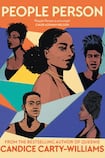
One of the most memorable debuts in recent years was Candice Carty-Williams’ Queenie, a bestseller about the experiences of a young black woman trying to navigate a messy relationship with a white man in contemporary London. Told in a first-person voice that was warm, funny and insightful, the book was shortlisted for a Costa Award, longlisted for the Women’s Prize, and named Book of the Year at the British Book Awards in 2020.
Carty-Williams is also a prolific screenwriter and journalist, the woman behind the Guardian and 4th Estate BAME Short Story Prize, the first inclusive initiative of its kind in book publishing. Other details of her impressive biography tell us that she was “born in 1989, the result of an affair between a Jamaican cab driver and a dyslexic Jamaican-Indian receptionist”.
It’s a line that captures the tone of her fiction, which is deadpan and arresting and frequently inquiring, from a writer who highlights the humour in everyday life, while also trying to understand what makes people tick. This objective is to the forefront of her second novel, as evidenced by its title, People Person. Protagonist Dimple Pennington is a 30-year-old aspiring lifestyle influencer, whose fake online life is nothing like reality. To her small (but growing) following, Dimple is outgoing, popular and in a tumultuous romance with bad-boy Kyron. In the real world she has no friends and is struggling to get out of a relationship mired by emotional blackmail and coercive control.
Cyril is brilliantly drawn, a man who cares about no-one but himself, perennially broke and petrified of responsibility
Two concurrent storylines develop this premise in imaginative ways. An inciting incident sees Kyron have a nasty fall in Dimple’s house, which prompts her to call her estranged half-siblings in a desperate bid for help (with echoes of My Sister, the Serial Killer by Oyinkan Braithwaite in both plot and tone.) Together the siblings form a very new take on the Famous Five, with each member rendered distinctly through Carty-William’s luminous characterisation.
An early chapter – arguably the strongest in the book – sees Nikisha, Danny, Dimple, Lizzie and Prynce, who have the same father but different mothers, meet each other as children, when their errant father Cyril rocks up in a gold Jeep to take them on an outing to a park. It’s a clever conceit that naturally introduces the back stories of the siblings and sets up the rivalries and tensions that play out in adult life.
Cyril is brilliantly drawn, a man who cares about no-one but himself, perennially broke and petrified of responsibility. Over the course of the novel, his lack of interest in his children is successfully played for laughs, though the heartbreak this causes also comes through. He is, quite literally, a man who loves his Jeep more than his kids, but small glimmers of humanity save him from being a total monster, such as when he tells Nikisha, the eldest, to watch out for Dimple: “You look at her in a way she nah understan’ and she’s weeping. So we haffi treat her wid kindness.”
There are cliches aplenty – the mighty fall; straws break camels' backs; people wither inside while smiling on the outside
Carty-Williams excels when writing in the Jamaican patois – “All is bless!” says Cyril, as all around him, mayhem unfolds – but there is a huge amount of dialogue in this book, pages and pages of action unfolding through lengthy conversations, which are often expository in nature. The prose is pedestrian, a functional third-person perspective that lacks the intimacy of the first-person voice in Queenie. There are cliches aplenty – the mighty fall; straws break camels’ backs; people wither inside while smiling on the outside – and occasional syntax issues, such as “a dark blonde bob whose mother lived on the block near the bus garage,” or a line that tells us, “When Cyril pulled up, Prynce was already outside eyeing the gold Jeep suspiciously”.
Elsewhere, the suspense of the Kyron storyline is heavy-handed, with blackmailing texts used as cliffhangers at the end of chapters, the resolution of which ends with a whimper. Much better is the way the other – and to my mind far stronger – storyline unfolds, namely with a confrontation scene between Cyril and his adult children that is realistically understated and full of pathos.
As with Queenie, People Person has plenty of thought-provoking details on the experience of black people in Britain, from the plight of first-generation immigrants, such as Cyril, who had their lives upended by the move, to the casual racism and microaggressions still faced by Dimple and her siblings today. The white nurses in the hospital think Kyron looks like “a young Denzel Washington or Idris Elba”. The mother of a missing son is told by police, “If you can’t find your son then how can you expect us to?”. These kinds of searing asides keep the narrative buoyant, in this novel about people, and how awful and wonderful they can be.












